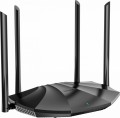Add to comparison |  |  |
|---|---|---|
| Tenda TX2 | Tenda TX2 Pro | |
| Outdated Product | Compare prices 1 | |
| User reviews | ||
| TOP sellers | ||
| Product type | router | router |
| Data input (WAN-port) | Ethernet (RJ45) Wi-Fi | Ethernet (RJ45) Wi-Fi |
Wireless Wi-Fi connection | ||
| Wi-Fi standards | Wi-Fi 3 (802.11g) Wi-Fi 4 (802.11n) Wi-Fi 5 (802.11ac) Wi-Fi 6 (802.11ax) | Wi-Fi 3 (802.11g) Wi-Fi 4 (802.11n) Wi-Fi 5 (802.11ac) Wi-Fi 6 (802.11ax) |
| Frequency band | 2.4GHz 5 GHz | 2.4GHz 5 GHz |
| Operating ranges | dual-band (2.4 GHz and 5 GHz) | dual-band (2.4 GHz and 5 GHz) |
| Wireless speed 2.4 GHz | 300 Mbps | 300 Mbps |
| Wireless speed 5 GHz | 1201 Mbps | 1201 Mbps |
| Bandwidth | 80 MHz | |
Connection and LAN | ||
| WAN | 1 port 1 Gbps | 1 port 1 Gbps |
| LAN | 3 ports 1 Gbps | 3 ports 1 Gbps |
Antenna and transmitter | ||
| Number of antennas | 4 | 5 |
| Antenna type | external | external |
| MU-MIMO | ||
| Gain | 6 dBi | 6 dBi |
| Transmitter power | 23 dBm | 23 dBm |
| Signal strength 2.4 GHz | 20 dBm | 20 dBm |
| Signal strength 5 GHz | 23 dBm | 23 dBm |
Functions | ||
| Features | NAT repeater Beamforming firewall | NAT repeater Beamforming firewall |
| More features | DHCP server DDNS DMZ | DHCP server DDNS DMZ |
Security | ||
| Safety standards | WPA WEP WPA2 WPA3 | WPA WEP WPA2 WPA3 |
General | ||
| Operating temperature | 0 °C ~ +40 °C | 0 °C ~ +40 °C |
| Dimensions | 239x144x40 mm | 239x144x40 mm |
| Color | ||
| Added to E-Catalog | april 2024 | january 2023 |